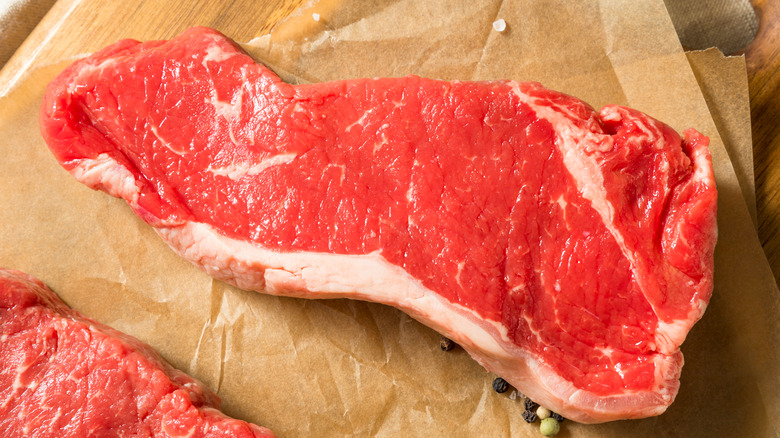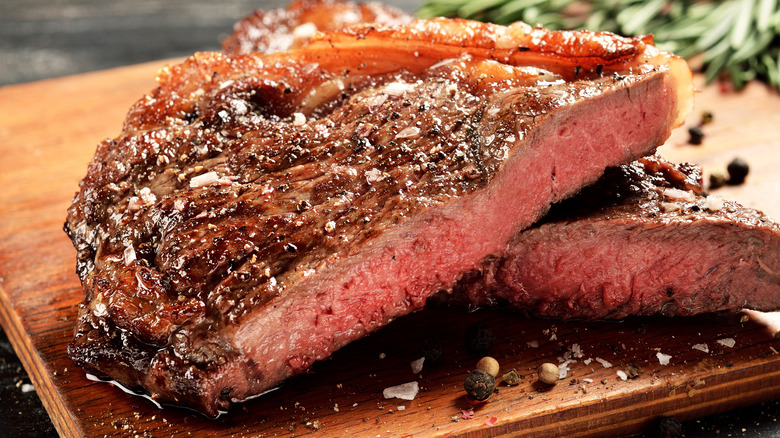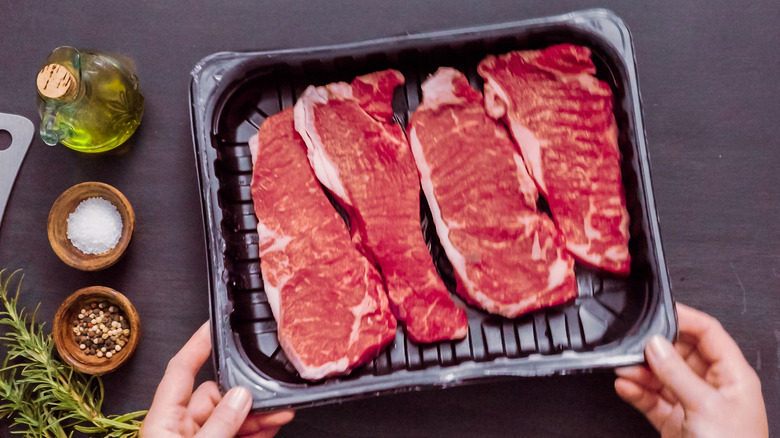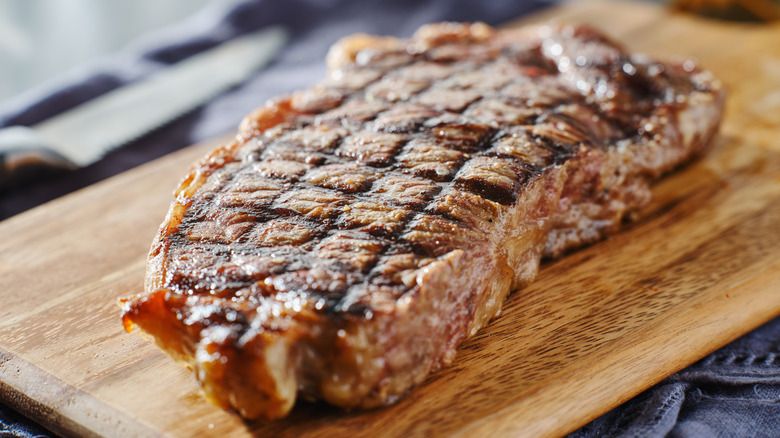Everything You Should Know About NY Strip Steak
The NY strip is one of the most tender steaks, according to the Food Network, and offers an "assertive beefy flavor." The main muscle in the steak is the longissimus dorsi that runs from the hip bone to the shoulder blade (via The Spruce Eats). The NY strip has less marbling, or intramuscular fat, than a ribeye and doesn't cost as much. In fact, it's often one of the lowest-priced steaks on the menu, making it a steak steal!
According to Omaha Steaks, the New York strip comes from the short loin subprimal, part of the loin primal. Sometimes the bone is left attached. The ever-popular filet mignon is also cut from the loin primal. If a butcher leaves the strip loin and tenderlolin intact, then a T-bone or a porterhouse can be produced. This means if you really like tenderloins and NY strips but can't decide which to order, then a porterhouse or a T-bone might be your best bet! It's like getting two steaks in one (via Omaha Steaks). Talk about a twofer!
Where did the NY strip get its name?
Not surprisingly, the restaurant that put NY strip steak on the map is located in New York City. According to The Texas Steak Warehouse, Delmonico's opened in 1837 and served a steak that guests couldn't resist. It gained quite the reputation, and people started referring to it simply as a "New York Strip." Interestingly, a "Delmonico steak" that is now served throughout the country isn't necessarily a New York Strip, according to The Daily Meal, rather the name can refer to any thick-cut, high quality steak.
The steak goes by other names, like ambassador steak, strip loin steak, or club steak, and even other locations lay claim to it, resulting in monikers like Kansas City strip steak and Omaha strip (via Omaha Steaks). Also, don't expect to see a New York strip on the menus of every country you travel to. According to Steak Society, it may have a different name in the UK, Australia, or New Zealand. Regardless of how the menu labels it, ordering this cut of meat will be a reward for your taste buds.
Buying a NY strip
You can buy NY strips from the grocery store as well as at your local butcher. The trick to buying pre-packaged NY strips, according to The Spruce Eats, is to "look for ones cut from the rib end or the center of the strip loin." The way to do this is to examine the steak's shape.
The cut you want should be wide, pretty straight, and consistent in width throughout. If the steak is wavy-shaped, resembles a question mark, or has one end that is noticeably narrower, the cut is from closer to the sirloin end. Some steaks are labeled "center-cut," but this means that it can't be the very last steak cut from the sirloin end. As for the fat, it should be trimmed to one-eighth-of-an-inch all the way around (via The Spruce Eats). Once you get your steaks home, it's time for the next meaty challenge.
Preparing a NY strip steak dinner
The great thing about having a flavorful cut of meat is that it doesn't require much seasoning! According to Good Housekeeping, "If you want to get fancy," you can flavor the oil the steak cooks in with ingredients like rosemary, garlic, or shallots, but you really don't need much more than salt and pepper to make a NY strip steak into a satisfying meal. The outlet recommends searing the steak on both sides and finishing it off in the oven. If you're yearning for a little more culinary creativity, you can always get extravagant with your sides.
Whether it's the tongue sizzling spice of St. Elmo's shrimp cocktail sauce or the gigantic slabs of Canadian bacon at Peter Luger's, steakhouse sides can take on a legendary status all their own. And, why shouldn't they? If you have to pay extra for a side at a steakhouse, you're going to want it to be good! The Daily Meal put together a roundup of steakhouse sides that are more impressive than just your basic baked potato. So, if you're cooking a NY strip steak, why not attempt a fancy side dish? You can always be a legend in your home, after all.



